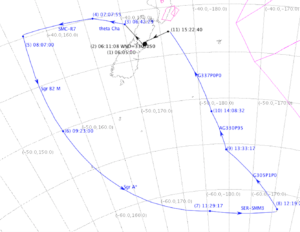Dr. Kimberly Ennico Smith
Last week aboard SOFIA, our observations included studying star formation regions in the Small Magellanic Cloud, a neighboring galaxy to our own Milky Way, a super-massive black hole, and the center of our Milky Way Galaxy. The method we used for these studies is called spectroscopy, and in more particular, high-resolution spectroscopy. The instrument onboard can isolate the wavelength, or frequency, of a particular atomic or molecular transition, allowing scientists to measure how fast and in which direction the molecule is moving.
When observing on SOFIA, the time spent on each celestial target is planned in advance, taking into account the position of the object in the sky, the direction of the aircraft, and the motion of the sky throughout the observation. When you add in the constraints that the airplane must take off and land at Christchurch International Airport and that the telescope only looks out the left (port) side of the plane, it makes for unique flight plans each night. Often the same targets are observed on multiple flights to get all the data we need.

We, as humans, cannot see infrared light with our eyes. So, we are thankful to have SOFIA’s telescope and instruments which enable us to study the infrared solar system and beyond.
During the June 28 flight, we observed a target called Sagittarius A, or SgrA (pronounced ‘Sag A-Star’), which when viewed from Earth is in the constellation Sagittarius. Evidence has been mounting that SgrA is a supermassive black hole, as telescopes have measured the speeds of stars orbiting that point in space at much higher speeds than any other star in the galaxy.
Using the powerful instruments on SOFIA, we are studying atomic oxygen in the gas surrounding the black hole, which can only be studied with far-infrared wavelengths of light that do not reach Earth’s surface. The researchers onboard are trying to measure the amount of neutral (not ionized) gas that is falling into the black hole. With SOFIA they can actually determine how fast the gas is moving and its direction of motion using the high-resolution instrument onboard. Combining measurements of both the gas’s velocity and mass will help us understand how the black hole at the center of our galaxy is accumulating mass from its surroundings, due to its large gravitational pull.

